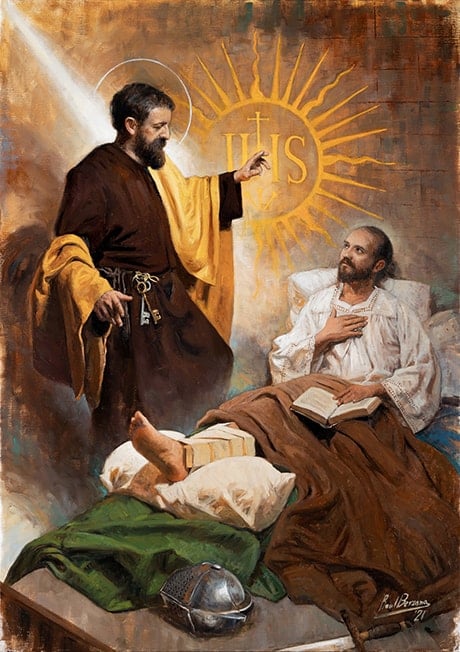The Ignatian Year will soon come to an end with the Feast of St. Ignatius on Sunday, July 31. Arturo Sosa, SJ, the Superior General of the Society of Jesus, invited us to reflect on St. Ignatius’ conversion asking for the grace to see all things new in Christ. We meditated on a particular event in his life: that day when Ignatius, struck by a cannonball, began his transformation from Ignatius the soldier into Ignatius the pilgrim. I can picture Ignatius lying on his bed wrestling with God about the physical and emotional pain he was enduring. For me, the Ignatian Year was an invitation to quiet down and reflect on how God was asking me to pay close attention to difficult situations in my own life. I felt God telling me, “Orlando, pay attention to what is catching your attention. I have something to communicate.”
But this quieting-down business is very difficult for me. I am immersed in and distracted by the busyness of life: work, studies, family, social struggles, electronic devices! I find that the more I try to quiet down, the more I am triggered by other kinds of noise; the news about the war in Ukraine, a long conversation with a friend about the Church’s teaching on abortion , or an op-ed piece I read about about who can and should receive the Eucharist. Out of these interactions, new questions arise which, in turn, lead to more things to consider, and the cycle of unending and unresolved questions continues. My mind is often restless, going from one thought to another. Yet, it was there – in the midst of the distractions, the noise and the struggle of quieting down – where God was inviting me to pay attention and inquire further. Why do I feel hopeless about the war, for example? Why did I feel threatened after engaging in a difficult conversation about abortion with my friend? Why am I so distracted? “Pay attention to what is catching your attention.” God was choosing the distractions and noise I was experiencing to uncover His grace.
When I first read about the Ignatian Year, it felt somewhat strange that we were asked to “celebrate” the 500th anniversary of an injury and an abrupt and unsolicited arrest. How could we celebrate a defeat, a failure, a pain? The reality is that God is present in both our highs and lows. We find God not only through our experiences of joy and stability, but God’s grace breaks through our defeats, failures, struggles and confusions. Why were we invited to reflect on the 500-year anniversary of a shattered life, then? Because, just as Ignatius, we too endure defeat, failure, and pain. We, too, struggle with the noise and confusion resulting from these experiences. The Ignatian Year served as an invitation to allow the Lord to work on my own daily conversion, and in doing so, to uncover a new apostolic enthusiasm, a new life, and new ways of following Him. I was invited not to run away from pain, conflict, and unending thoughts, but to wrestle with God with what had been catching my attention.
When I speak of wrestling with God I am not suggesting fighting against God. Before entering religious life, there was a time when I fought against God. After a painful breakup, I began to avoid everything that had to do with God and the Church. I partly blamed God for the breakup, and I did my best to cut ties with the faith and just go on with my life. I was fighting against God. Those were the most miserable years of my life. Wrestling with God is different. To wrestle with God is not to cut ties and run away from Him. On the contrary, to wrestle with God means to engage Him with our doubts, questions, hurts and disappointments, as well as with our desires and joys. One of the most difficult experiences I have endured so far in my life was my dad’s illness and his eventual passing in the fall of 2020. From denial to anger, to sadness and eventual hope, it was a time of wrestling with God. I was initially consumed by anguish, fear, and uncertainty. But when I began to actively engage God in my hopelessness, I gradually began to experience His closeness. He is, after all, the God of hope, full of mercy and new beginnings. When we give ourselves permission to wrestle with God, perspectives in our lives begin to change. Our hearts are set free and our relationship with Him deepens.
Ignatius’ conversion began by paying attention to what was in front of him at the time; wrestling with God about what it all meant; and embarking on a long pilgrimage of conversion. If we are to take our conversion seriously, then we must also pay attention to what is happening in our lives and be willing to wrestle with God through our joys and highs, as well as through our doubts, our struggles, our pains (our lows). At times, this will feel like a fierce battle. Why am I suffering? Why is this happening to me, to my family? Why this terminal illness? Why me? Other times, we may be complacent thinking that all is well and we are living a happy, fulfilled life. The Ignatian Year challenges us to pay close attention to what is catching our attention and to engage God in our own pilgrimage of conversion: a conversion away from an old and sterile form of life to a new and flouring life in Christ.
What is catching your attention these days? Is it a family matter, financial struggles, work stress, a strained relationship? A distraction? A feeling of boredom, lethargy or general life dissatisfaction? How about a joyful or gratifying moment you recently experienced? Or maybe it has to do with the current political and social divide in our country. Whatever the situation may be, the way St. Ignatius confronted his own reality gives us some clues as to how to embrace our own. In this Ignatian Year let us bring what is catching our attention before the Lord asking for the grace to see all things new in Him. And as we wrestle with God about these things, be assured that He is inviting us to a deeper conversion.
Pay attention to what is catching your attention; God has something to say.
-//-
The above painting, the work of the Spanish artist Raúl Berzosa, depicts the moment of the conversion of the Holy Jesuit. The flag re-proposes a particular one: the IHS monogram “Iesus Hominum Salvator”, coat of arms of the Jesuits. Berzosa created the painting for the Ignatian Year and was featured on a Vatican stamp.


